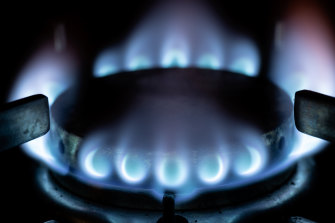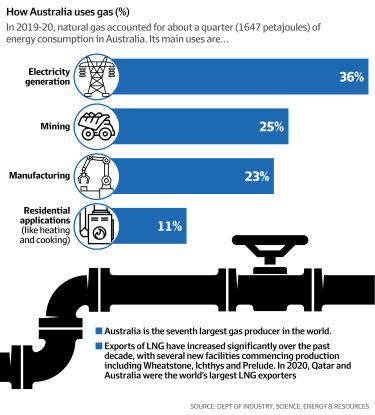Clean energy plan leaves too much gas in the tank

The Victorian government’s long-awaited “gas substitution road map” was quietly released over the weekend – surprising given the scope of the plan to wean Victorian households off our current gas dependence and pave the way for all electric, renewable-powered homes.
While we welcome the removal of rules that forced households to use gas in their homes, the road map lacks clear goals and timelines for this urgent transition to take place, and even more worryingly, it fails to rule out the potential use of dirty hydrogen made with methane gas.
The Victorian government released its “gas substitution road map”.Credit:Bloomberg
At present, gas is responsible for about 17 per cent of Victoria’s climate pollution. We are in the unenviable position of being the Australian state most reliant on gas. The current energy crisis has shown just how costly Victoria’s dependence on polluting gas is – it remains the most expensive source of power in our energy network.
The Andrews government road map recognises that supporting homes and businesses to shift to clean, cheap electricity is the best way to protect Victorian households and businesses from skyrocketing energy prices fuelled by the volatile global fossil fuel markets. The fact it has now been released in the midst of an icy winter is genuine progress – but it doesn’t go nearly enough.
Certainly, there are aspects to this plan we applaud – the shift to the 7-star construction code that increases the environmental performance requirements of new buildings, and removal of plumbing regulations that incentivised gas hot water are positive steps. The improved support for household electrification through the overhauled Victorian Energy Upgrades Program, which provides incentives for households to shift to more energy-efficient household appliances, should help homeowners enjoy the benefits of cheap, clean renewable energy.
Removing antiquated requirements that forced developers and homeowners to pipe gas into new homes is a long-overdue and welcome move. However, the road map stops short of banning new gas connections which is a missed opportunity that will result in decisions about new gas connections left to big property developers.
Gas use in Australia.Credit:
To match the scale of the energy and climate crises Victorians face, this plan should have gone further.
Apart from the considerable health and climate impacts of remaining wedded to fossil fuels, we’ve all seen the negative consequences of being exposed to the global energy markets, with households and businesses dealing with double-digit leaps in energy bills since the start of this year.
The road map fails to rule out using dirty hydrogen made with gas. This is something the gas industry has lobbied hard for, so they can preserve their profits and the value of their gas pipeline assets, at the expense of our health and climate.
This road map should have included a major and urgent investment in electrification across Victoria, coupled with support to develop local clean industries so we can heat our homes with locally made heaters and hot water services.
With plans underway for a new gas terminal in Geelong, and with the Victorian government having approved oil company Beach Energy to begin drilling in Port Campbell National Park, the lack of clear timelines in this road map leaves Victoria vulnerable to the potential spectre of new drilling under the iconic 12 Apostles and the presence of giant gas tankers in Port Phillip Bay.
Following the remarkable momentum from the strong vote for climate action at the recent federal election, Victorians rightly expect more decisive plans to rapidly shift to 100 per cent renewables. For a government that talks big on climate, Victorians will be left to scratch their heads and ask – where is the big vision for a gas-free Victoria?
Clearly, the writing is on the wall that gas is on the way out in Victoria. We give due credit to the Andrews government for at least acknowledging this in their plan.
But with the serious gaps in this road map, the November state election leaves open an opportunity for Matthew Guy to step up and announce his own bold vision for electrifying Victoria.
We urge political leaders from all sides to put their finger to the wind and feel the appetite for a fast and decisive clean energy transition in which no one is left behind – whether they are a worker in the gas industry or a low-income earner trying to heat their home in winter.
Most Viewed in National
From our partners
Source: Read Full Article

